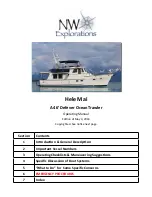
Any time you take your boat out, make sure that there is at least one other passenger aboard who is
familiar with the operation of your boat.
Ensure that all passengers are properly and securely seated in appropriate seating locations to avoid
falling or falling overboard.
While the engine is running, and while the boat maneuvering, all occupants should be properly seated.
DO NOT stand while the boat is moving.
DO NOT sit on the engine box, seat backs, transom seating, sunpad, boarding platform or gunnels while
the boat is underway. You could fall overboard and be hit by the propeller, or another boat.
DO NOT allow objects, arms or legs, or any other body parts to hang over the bow or gunnels. Stay
within the boat.
Passengers should not sit in locations that obstruct the operator’s visibility.
Persons and gear should be stowed in a way that distributes weight appropriately and in a manner that
trims the boat properly (pitch angle). Excessive weight at either the bow or the stern relative to one
another can cause trim problems leading to reduced driver visibility, erratic steering, loss of control, or
bow submergence and flooding/swamping.
Passengers should be well aware of emergency equipment and instructed in its use.
Passengers should assist with lookout duties and notify the operator of any approaching watercraft or
potentially unsafe conditions to provide assistance with collision avoidance.
Carbon Monoxide (CO) is a deadly, colorless and odorless gas produced by all engines and fuel-burning
appliances. Even with the best boat design and construction, plus the utmost care in inspection, operation
and maintenance, hazardous levels of carbon monoxide may be present in or near the boat under certain
conditions. The boat owner, operator, as well as all boat occupants, must understand the dangers of carbon
monoxide and must comply with all safety recommendations/requirements. For boats with cabins, always
ventilate the boat interior and avoid boating situations which cause increased exposure.
Carbon monoxide (CO) can cause brain damage or death. Engine
and generator exhaust contains odorless and colorless carbon
monoxide gas. Carbon monoxide will be around the back of the
boat when engines or generators are running. Move to fresh air, if
you feel nausea, headache, dizziness, or drowsiness.
• Do not allow people to be on or near the swim platform or in the water near the swim platform while the
engine is running. Carbon monoxide will exist around the back of the boat when engines are running.
• Do not operate the engine in a confined space or while the boat is tethered to another vessel.
• Do not go under the boat cover while the engine is running or shortly after the engine has been running.
Carbon monoxide may be trapped under the cover. It is important to remove the cover and/or ventilate
the area before going under the boat cover.
• Do not “platform/teak” surf or platform drag. Carbon monoxide will exist in high concentrations in
the vicinity of the swim platform near the water while the engine is running. The USCG has deemed
platform dragging as a dangerous and hazardous activity which should be prohibited, as it can result in
injury or death.
• In the event that someone exhibits the symptoms of carbon monoxide exposure (nausea, headache,
dizziness, or drowsiness), have them breathe fresh air and, if necessary, immediately seek medical
attention.
Hazardous boating situations involving
carbon monoxide include:
Blockage of boat
exhaust by obstruction.
CARBON
MONOXIDE
SAFETY
2016 Axis Wake Research Owner’s Manual . . . Page 1-12
Summary of Contents for A20
Page 4: ......
Page 6: ...TABLE OF CONTENTS ...
Page 10: ......
Page 48: ......
Page 60: ...SEATING GUIDES 2016 Axis Wake Research Owner s Manual Page 2 13 T22 T23 A24 ...
Page 72: ...2016 Axis Wake Research Owner s Manual Page 2 25 ...
Page 102: ...SAFEGUARDING THE AXIS EXPERIENCE ...
Page 120: ...AXIS WAKE RESEARCH LIMITED WARRANTY ...
Page 134: ...2016 Axis Wake Research Owner s Manual Page 5 15 Date Date Date Date Date Date Date Date ...
















































